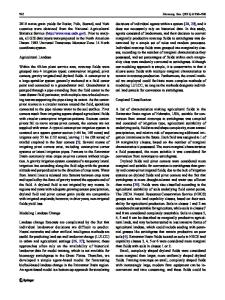Routes to Cellulosic Ethanol
The perception that civilization is crossing a period of Global Climatic Changes that can seriously threaten our lifestyle, along with energy security and the search for prosperity, are the main drivers that are pushing men to use more biomass as a source
- PDF / 1,727,112 Bytes
- 21 Pages / 439.37 x 666.142 pts Page_size
- 19 Downloads / 461 Views
Cell Wall Genomics in the Recombinogenic Moss Physcomitrella patens Michael A. Lawton and Hemalatha Saidasan
1 Introduction The growing interest in cellulosic ethanol as a sustainable biofuel has focused attention on modifying plants and plant cell walls in particular so that they can serve as a more effective feedstock for ethanol production. A substantial effort is now underway to develop methods that can increase the efficiency of cellulose breakdown by chemical or enzymatic pretreatments in order to generate fermentable sugars. This approach is leading to novel technologies for preprocessing and cell wall digestion, and the identification, selection, and production of enzymes with improved properties for industrial application (for example, heat stable hydrolytic enzymes). Another extremely promising approach involves directly modifying the structure of the plant cell wall so that cellulose present in the biofuel feedstock is more readily available for downstream processing and is more easily hydrolyzed to fermentable sugars. A major challenge for biologists is to make these modifications without compromising the normal growth, function, and health of the plant. For example, efforts to reduce lignin content and thereby increase the accessibility of cellulose microfibrils to enzymic hydrolysis might also render the native plant more susceptible to infection by necrotrophic pathogens or compromise the ability of the plant to withstand physical and abiotic stress. While the plant cell wall is a primary focus for improvement, the economics of agriculture and the potential competition with food crops for arable land demands that we make every effort to improve the overall efficiency of biofuel crops and focus also on traits that increase yield, reduce losses to disease, decrease the need for inputs such as fertilizer and water, and allow biofuel crops to be grown on land that is currently underutilized or is unsuitable for conventional agriculture. For example, engineered or selected drought-tolerant
M.A. Lawton (*) Center for Agricultural and Environmental Biotechnology, Rutgers University, New Brunswick, NJ, USA e-mail: [email protected] M.S. Buckeridge and G.H. Goldman (eds.), Routes to Cellulosic Ethanol, DOI 10.1007/978-0-387-92740-4_14, © Springer Science+Business Media, LLC 2011
241
242
M.A. Lawton and H. Saidasan
biofuel crops might be grown in drought-prone regions or on lands that have poor soils that may not be able to sustain the cultivation of food crops. If we are to manipulate the plant cell wall in a predictive and useful manner, we need to develop a better understanding of the genetic, molecular, and biochemical mechanisms involved in cell wall biogenesis and maturation. This will require a more complete understanding of how plant cell walls are constructed at the molecular and biochemical level. In particular, we need to develop a broader and deeper knowledge of: (1) the nature of the primary and secondary structural components associated with different types of plant cell walls (the
Data Loading...











